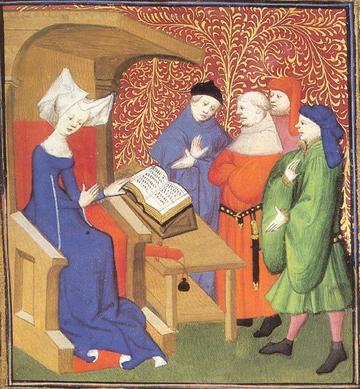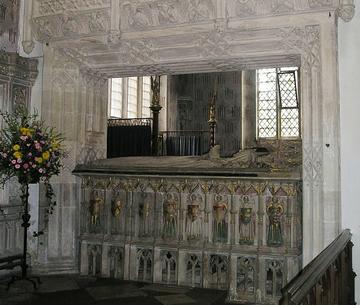The Widows of the Battle of Agincourt
Rowena Archer looks ahead to the Agincourt 600 exhibition opening at the Tower of London in October and considers ' the miserable, ,the resigned and the relieved.
The medieval battle basks in an imagined glamour of war with knights in shining armour and, in the case of the Hundred Years' War, the popular memory of a series of great English victories against the odds. This is especially so in the case of Agincourt thanks, of course, to 'we band of brothers' so unforgettably memorialised in the St Crispin's Day speech of Shakespeare's Henry V But war is not glamorous; rather it is a bloody affair that leaves thousands dead and creates immense grief for families. In the exhibition marking the 600th anniversary of Agincourt which is due to open at the Tower of London in October there is to be recognition of the women who lost their husbands on that muddy battlefield. We are more sensitive now to the horrors of war as commemoration of the First World War in particular bears witness.
With the ages for consent to marriage set at twelve for girls and fourteen for boys, women commonly experienced widowhood at a tender age. Under English common law, a widow was entitled for life to one third of her deceased husband's property, retaining it even if she remarried. For elite women there might also be a jointure, estates settled on the couple jointly in survivorship. At widowhood then the wife's share of an estate might be considerable but this hardly makes it attractive. Widowhood came in various ways but death in war was surely always a dreadful shock. A widow could remarry and find a new protector; retreat into a nunnery, hardly desirable if she had young children; continue her deceased husband's trade; or, in a small number of cases, to take up a new one.
In the midst of the public preparations for war in 1415, many individuals attended to the private matter of their impending absence and possible death and the impact this might have on their wives, by making a will. In England this process spanned many months, some wills only being drawn up when the army was already encamped at Harfleur for the long siege that marked the opening stage of the campaign. It was a common practice for husbands to appoint their wives if not the sole executrix, at least one of those charged with carrying out their last wishes. However routine this process, one may imagine that it was an emotional moment for wives who were naturally anxious to carry out tasks that would ensure safe passage into the next world, but surely hoping that they would not have to execute them just yet. The deaths, burials or disappearance of the men who fought has had more attention from historians than the widows. Between the celebration of success on the English side and the military and political despair among the Valois French seeking explanations, contemporary authors wrote little beyond a few generalities about the many women left as widows. One French commentator observed that 'Everywhere the lords and ladies of rank changed out of their garments of gold and silk into the clothes of mourning. It was a sight to bring tears to the eyes to see some of the women crying bitterly at the loss of their husbands'. Most of the individual personal tragedies, however, can only be imagined.
The most substantial exception is in contemporary literature from the Valois side, in Alain Chartier's courtly love poem the Livre des Quatre Dames written shortly after Agincourt. The text takes the form of a discussion between four ladies about their lovers who have been involved in the engagement. The first has been widowed; the second knows that her lover is in captivity in England and is desperate for news of him; the third is in equal measure in suspense, uncertain of her lover's whereabouts; and the fourth interestingly believes herself the most distressed of them all for her lover has survived through the cowardice of his flight. Whilst concerned about the issue of who was to blame for the disaster, Chartier nevertheless has offered a commentary on loss. All over France a great tranche of military society had been plunged into mourning, with whole families decimated by the battle.
An equally moving text is the Epistre de la Prison de Vie Humaine which was penned by a woman, Christine de Pisan, in 1418 and presented to a woman, Marie of Berry, daughter of Jean, duke of Berry (d.1416), uncle of King Charles VI.

Christine de Pizan (sitting) lecturing to a group of men standing
Christine, Italian by birth and French by upbringing, had been widowed in her twenties in 1392 and had taken the remarkable and unique decision to become a writer. Living in Paris she was very close to many of the major figures of the royal court, her father having been astrologer to Charles V. Marie had already been widowed twice; her third husband, Jean of Bourbon and the son of her second marriage, Charles, count of Eu were taken prisoner at Agincourt; and she counted among other deceased family members, her son-in-law, Philip, count of Nevers and Rethel. Christine's philosophical and advisory text was intended to offer consolation to Marie and to Bonne, countess of Nevers, on account of the Infortunee bataille' but it was extremely tough. Those who had died, she said, had lived great lives; they had escaped the prison of human life; besides, all men must eventually die and God comforts his people; and those who have died are with Him in Paradise. Philip of Nevers and Bonne had only married in 1413 but already had two children. His body was embalmed and taken to the abbey of Elan, in Rethel for burial. There can have been little comfort for Bonne or her sister-in-law, Elizabeth of Gorlitz, the widow of Anthony, duke of Brabant by whom Elizabeth had had a child in 1410 who only survived a few months. Anthony's body, found by his confessor two days after the battle, was solemnly carried home and buried in the private church of the ducal castle.
The case of Perrette de la Riviere captures a more defiant widow. Her husband Guy de La Roche-Guyon in Normandy, a chamberlain of Charles VI, was killed in the battle, as were her two brothersin-law. Perrette had four children and took
charge of the family estates but these were attacked by Henry V when he returned to France in 1417. Though she held out for a time Henry eventually took the chateau. He was unwise enough to grant it to Guy le Bouteiller, along with the hand of Perrette who refused to marry a traitor. Brought before the king five months later, she again refused the marriage at which point Henry V gave up and allowed her to depart with her children. In 1416 Jeanne de Gaillouvel who had been left with seven children petitioned the crown for her lands. Her husband was thought to be a prisoner in England and she feared losing his lands because others thought he was dead. Jeanne was allowed to hold the lands until the truth was discovered but the last we hear is that 'she still knows nothing for certain'.
Before the composition of L'epistre de la prison de vie humaine, in 1405 Christine de Pisan had written a manual of advice for women, Le tresor de la cite des dames, which she had presented to Margaret of Burgundy. Given her own experience of widowhood Christine is valuable in identifying the problems that widows might face. Her initial instruction was that the widow should tackle her husband's will and devote all her efforts to fulfilling his wishes quickly in order to ease the blessed soul of the man she loved. Christine recognised that the widow would lament her loss and advised seclusion for a time after the funeral and obsequies, though she warned that remembrance would last `as long as she lives'.
Insights into expressions of grief are limited in the middle ages. The setting up of memorials can offer some guidance. Tradition has it that Katherine de la Pole, countess of Suffolk built the porch of Fressingfield Church (Suffolk) in memory of a husband and a son. The former had made his will in July 1415 and had requested that if he died abroad either his body or his bones be brought home for burial in Wingfield Church (Suffolk). The will was brief, but bequests to Katherine dominate the text, and she was an executrix. Only weeks later Katherine's son Michael died at Agincourt. Given the few deaths among the English nobility, Katherine was horribly unfortunate. No will survives for Katherine's son, perhaps because he was under-age though his widow, Elizabeth, had borne him three daughters, the last on 4 June 1415. The Younger Michael's body was boiled after the battle of Agincourt, as was that of the duke of York, for ease of transport and it may well be that those of the Older Michael, in accordance with his instructions, were similarly prepared. Shortly after these tragedies the two dowager countesses entered the local convent at Bruisyard.

Monument (north side) to Alice Chaucer, Duchess of Suffolk, St Mary's Church, Ewelme
Once the practicalities were completed Christine de Pisan urged pragmatism. The widow should attend to the distribution of lands, find out what was her due, beware of cheats and 'defend her rights boldly by law and reason'. Beatrice of Arundel, widowed in October 1415 by the death from dysentery of Thomas Fitzalan, earl of Arundel had a long fight to secure her dower and Katherine of Suffolk had to put in a claim for wages owing to Michael. In France too lawsuits abounded. Charles, lord of Noviant was killed in the battle, leaving a widow Ysabeau de la Mareschalle. Evidently childless, Charles's lands were placed in the hands of his three sisters as it had not been possible to establish whether Charles's brother Jean, who would have been his heir, had also died in the battle. For Noviant's widow there was not much consideration and she was ordered to order depend upon her three sisters-in-law for her dower.
One of the youngest widows of the Agincourt campaign, certainly in England, was the granddaughter of Geoffrey Chaucer. Alice Chaucer was born about 1405, the only child of Thomas Chaucer and Maud Burghersh. Though a commoner by birth, Alice had valuable social connections, by virtue of the affair of her great aunt, Katherine Roet, with Edward III's son, John of Gaunt. In 1399, when Gaunt's legitimate son usurped the crown, Thomas Chaucer found himself a cousin of the king.
Using his connections he secured the hand of Sir John Phelip, a close companion of Henry V for his daughter. Although the union was uncanonical, since Alice was under-age, they were married by 1414 and the bride received ajointure in all the Phelip estates. On 20 June he made his will in London, leaving instructions for his body to be buried where it pleased God. Alice was to receive a covered cup of gold and a gold basin and the furniture of a hall and a chamber. John contracted dysentery at Harfleur, where according to the inscription on his tomb he had fought valiantly. He died on 2 October, but it is hard to imagine that the child Alice mourned him deeply.
For Alice this was not to be her only experience of widowhood as a result of war and indeed it can be argued that the Hundred Years' War deprived her of all three husbands. Sometime after 1421 she was remarried, to Thomas Montague, earl of Salisbury but in 1428, Thomas was killed at Orleans by shrapnel from a stray cannon ball. Her third marriage was to Salisbury's successor there, William de la Pole, earl of Suffolk William was eventually murdered in 1450, blamed by many for the loss of the French lands. Alice Chaucer lies in Ewelme Church, not next to any of her husbands, though Salisbury and Suffolk are remembered in the heraldry on her tomb, but in her patrimony. Her tomb is one of the finest surviving late medieval funeral monuments, a statement in alabaster, rich sculptural adornment and colour of how plain Alice Chaucer had risen to the rank of duchess, survived the vicissitudes of the Hundred Years' War and according to the inscription on her tomb died 'a serene princess’.
ROWENA E. ARCHER
For more information on the Agincourt 600 Exhibition go to agincourt600.com
Dr Archer is currently writing a biography of Alice Chaucer, duchess of Suffolk.



